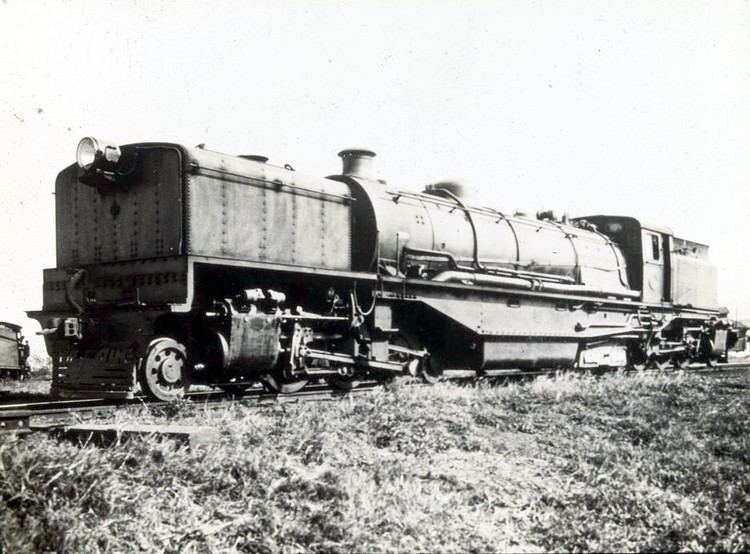Build date 1927 | Total produced 10 | |
 | ||
The South African Railways Class U 2-6-2+2-6-2 of 1927 was an articulated steam locomotive.
Contents
In 1927, the South African Railways placed ten Class U Union Garratt articulated steam locomotives with a 2-6-2+2-6-2 Double Prairie type wheel arrangement in service. The locomotive design embodied the Garratt design at the front end and the Modified Fairlie design at the rear end.
Manufacturer
Specifications for the Class GJ 2-6-2+2-6-2 Garratt locomotive were prepared by Colonel F.R. Collins DSO, Chief Mechanical Engineer of the South African Railways (SAR) in 1925, but the class designation was changed to Class U when orders for its design and construction were placed with Maffei in Munich, Germany. The locomotive design deviated from the Garratt principle, the patent of which was held by Beyer, Peacock and Company, and the end result was a hybrid locomotive, part Garratt and part Modified Fairlie. Ten locomotives were delivered in 1927, numbered in the range from 1370 to 1379.
Characteristics
The front end of the locomotive was of a typical Garratt arrangement, with a water bunker mounted on the front engine unit's frame, while the rear end was constructed in the Modified Fairlie fashion, with the coal bunker mounted on a rigid extension of the locomotive's main frame and with the pivoting rear engine unit positioned beneath the coal bunker. One reason which had been put forward for the construction of the rear end on the Modified Fairlie principle was to enable the coal bunker to be rigidly in line with the boiler frame, to ensure a satisfactory arrangement for the installation of the mechanical stoker. Since the locomotive was neither Garratt nor Modified Fairlie, its unique configuration was dubbed Union Garratt.
The locomotives were superheated and had round-topped fireboxes, Walschaerts valve gear and bar frames. In order to enable the longest boiler possible without increasing the overall length of the locomotive, the front engine unit was tucked in underneath the boiler frame somewhat further than was usual on a purebred Garratt locomotive. An additional underbelly water tank compensated for the resulting diminished water capacity of the front water bunker.
All the engine's water was carried in the front bunker tank and in the large underbelly tank, each tank with a capacity of 2,640 imperial gallons (12,000 litres; 3,170 US gallons). The rear bunker carried only coal and had a capacity of 14 long tons (14.2 tonnes). The main frame therefore carried the smokebox, boiler, firebox, cab, coal bunker, as well as the underbelly water tank.
The Class U were large and powerful locomotives. With their 60 square feet (5.6 square metres) firegrate, they were originally equipped with mechanical stokers of the duplex type, but these were removed at the Germiston shops in 1937. Two reasons were given for the removal, firstly that the locomotives were being used in short-haul service on the Reef by then, and secondly that the stokers were difficult to clear in the event of a blockage.
Shortcomings
The Class U locomotives were found to be somewhat sluggish, as delivered. An alteration of the exhaust passages, carried out c. 1933, resulted in a considerable improvement, even though the modification was preceded by considerable controversy and correspondence.
The Modified Fairlies and the Union Garratt variations of it were not successful and they suffered from the same shortcomings. On the Union Garratt, as on the Modified Fairlie, the frame was also prone to metal fatigue and cracking, brought about by the long frame overhang at the rear beyond the engine unit's pivot centre. The overhang, laden with the coal bunker of which more than 80% extended beyond the rear pivot centre, was subjected to severe vertical vibration while the locomotive was in motion and this led to structural weakening of the frame over time.
In addition, the rear pivot bearings were subject to quite rapid wear, since they carried a considerable additional vertical load compared to those on a pure Garratt. As was the case with the Modified Fairlie, this required increased frequency of maintenance and, as a consequence, increased operating cost.
Service
The Union Garratts, referred to as U-boats by the enginemen, were placed in service on the Witwatersrand, where they eventually ended up being used mainly for pick-up work and local workings. Two locomotives were employed on the coal line between Vryheid and Hlobane in Natal. Even though the Class U proved to be less successful than the purebred Garratts, some of them remained in service for more than thirty years. All ten were withdrawn from service by 1958.
Knuckle couplers
In 1927, the SAR began to convert the couplers of its Cape Gauge rolling stock from the Johnston link-and-pin coupling system, which had been in use since the establishment of the Cape Government Railways in 1873, to AAR knuckle couplers. Judging from the official SAR Locomotive Diagram Book, the dimensional drawings as published by Holland, which were for the most part based on the original as-delivered and unmodified locomotives, as well as contemporary photographs, the Class U were acquired new with knuckle couplers fitted, as were the Classes 18, GCA, GF and HF, which also entered service in 1927.
Conversion of all rolling stock was to take several years and both coupler types could still be seen on rolling stock into the late 1950s. During the transition period, knuckle couplers on locomotives had a horizontal gap and a vertical hole in the knuckle itself to accommodate, respectively, a link and a pin, to enable it to couple to vehicles which were still equipped with the older link-and-pin couplers.
